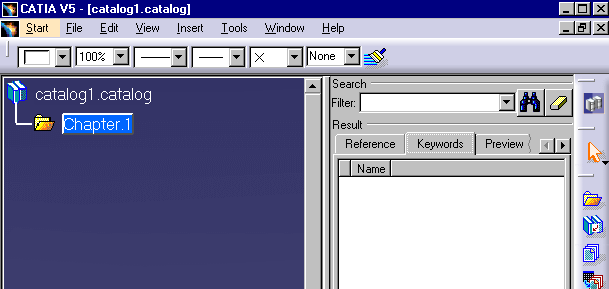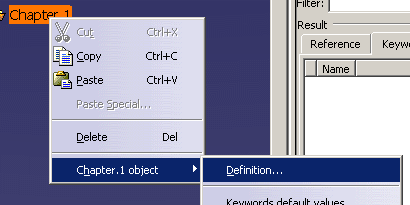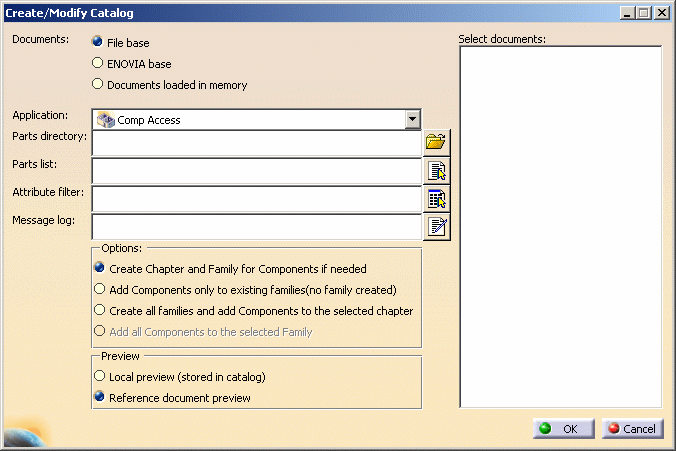 |
This task explains making sub-catalogs. You
may need to create several catalogs if you are creating a catalog of
resolved parts. |
 |
It is recommended that you keep the size of
each catalog to about 500 documents. Most users will, therefore, need to
create several catalogs if they are pointing to resolved parts. This task
explains how to use sub-catalogs, and to view them all through one master
catalog. The standard catalog creation facility is used to create the
sub-catalogs. In fact, Steps 1 to 4 are exactly the same as described in
the task Creating a Catalog. Creating a master catalog and linking it to
the sub-catalogs involves an additional step that is also explained here. |
 |
1. |
Open the Catalog Editor by clicking on
Start-Infrastructure-Catalog Editor.
The Catalog Window opens with a basic catalog structure in the left column.
Catalogs are created analogous to books, with the book being at the top
level, chapters under it, and, if necessary, sub-chapters under them, and
with pages (or parts) at the lowest level. Each family contains references
to one or more parts.
The illustration below shows the Catalog Editor. The column to the left
is where your chapters and families are displayed. The column to the right
will display parts when you click on a family.

|
|
|
2. |
Rename the root chapter (Chapter.1 above) to XXX Part to
reflect the application you are working in. In the case of Piping Design,
for instance, it will read Piping Part. If you do not do this you will have
an extra level in the tree. To rename, right click on it, select Chapter.1
Object - Definition. Enter the new name in the dialog box that displays.

|
|
3. |
Select the chapter under which you
want to create the catalog (in this case Piping Part). Click the
Create/Modify Catalog button
 . The Create/Modify
Part Catalog dialog box displays. . The Create/Modify
Part Catalog dialog box displays.

|
|
4. |
Select the application in which you
want to create the catalog by clicking the down arrow in the Application
field. |
|
5. |
There are now two ways in which you
can create a sub-catalog.
- If the parts you want in your sub-catalog are stored in one directory
- and there are no other parts in that directory - then click the button
next to the Parts Directory field and navigate to the directory where
your parts are stored. Click OK and all the parts in that directory will
be placed in the catalog. The application will automatically determine
what the chapter and family are and create them accordingly. If you have
only reducing tees in the directory it will create the chapter Branch,
then the family Reducing Tee under it, and place all the parts in it. If
you have reducing tees and blind flanges in it, it will create the
chapters Branch and Flanges, and the families Reducing Tee and Blind
Flanges under them.
- If your parts are in one directory but you want to store them in
separate catalogs, then you need to create a text file for each
sub-catalog that you want to make. Give the files any names you want. In
each file list the names of the parts (each must be on a separate line)
that you want to place in a sub-catalog. After you select the directory
in which your parts are, click the button next to the Parts List field
and navigate to the text file you created. Click OK.
|
 |
The Attribute Filter field can be
left blank, it is not needed for this process. If you want to have a log of
the process then create a file and enter the location in the Message Log
field. |
|
6. |
Make as many sub-catalogs as you
need to and save each one as you make it. |
|
7. |
You may now want to make a master
catalog and link it to all your sub-catalogs - this makes it convenient to
view all your parts. Repeat Steps 1 & 2 as explained above, then select
your catalog and click the Add Chapter button
 . Enter the chapter name
in the dialog box that displays, for instance, Branch. The chapter displays
beneath your catalog. . Enter the chapter name
in the dialog box that displays, for instance, Branch. The chapter displays
beneath your catalog.
|
|
8. |
Open the sub-catalog you want to
link to in this application - Tile Vertically or Horizontally so that you
can view both. Select a chapter in your master catalog. Click the Add Link
to Catalog button  , and then select the family you want to link to in the sub-catalog. The
family will display beneath the chapter in your master catalog. Add as many
chapters and families as you want to and save the master catalog. In the
image below both catalogs have been opened and tiled vertically.
, and then select the family you want to link to in the sub-catalog. The
family will display beneath the chapter in your master catalog. Add as many
chapters and families as you want to and save the master catalog. In the
image below both catalogs have been opened and tiled vertically.
 |
![]()